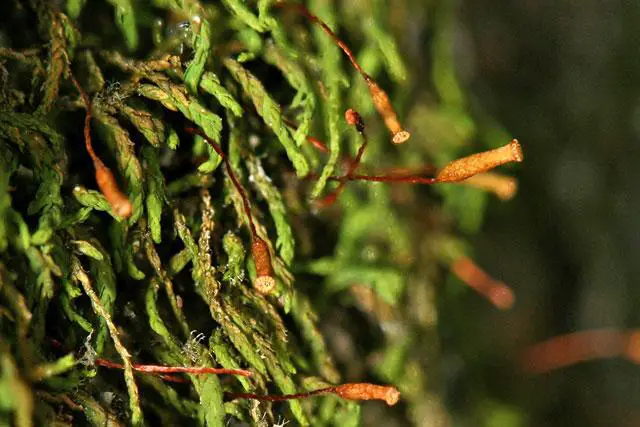
leskea_gracilescens_5.jpg from: https://www.delawarewildflowers.org/plant.php?id=2725&mode=F&famid=250
Introduction
Welcome to the fascinating world of Leskea gracilescens Hedw., a delicate and captivating moss species belonging to the Leskeaceae family. Often referred to simply as Leskea

Leskea-gracilescens-9.jpg from: https://ohiomosslichen.org/leskea-gracilescens-9/
, this unassuming plant has captured the hearts of bryophyte enthusiasts worldwide with its intricate beauty and remarkable resilience.

2776981385_894ff46453_b.jpg from: https://www.flickr.com/photos/ecoheathen/2776981385
Background
Before we delve into the intricacies of Leskea gracilescens, it’s essential to understand the broader context of mosses. These diminutive plants belong to the Bryophyta division, which encompasses a diverse array of non-vascular plants known as bryophytes. Bryophytes play a crucial role in various ecosystems, acting as pioneers in colonizing new environments and contributing to soil formation and moisture retention.
Main Content
Morphology and Identification
Leskea gracilescens is a true marvel of nature, with its slender, creeping stems adorned with delicate, feathery leaves. These leaves are typically lanceolate in shape, tapering to a fine point, and arranged in a spiral pattern along the stem. The moss often forms dense, velvety mats or cushions, creating a verdant carpet on the surfaces it inhabits.
One of the most distinctive features of Leskea gracilescens is its bright green coloration, which can take on a golden hue when exposed to direct sunlight. This vibrant hue is a result of the moss’s ability to produce specialized pigments that protect it from harmful UV radiation.
Global Distribution and Habitat
Leskea gracilescens

Anomodon-minor-sporophytes-750×499-24mf97x-300×200.jpg from: https://u.osu.edu/biomuseum/2015/11/09/what-does-it-mean-to-be-a-moss/
is a cosmopolitan species, meaning it can be found in various regions across the globe. It thrives in temperate and subtropical regions, often inhabiting moist, shaded environments such as forests, rock crevices, and the bases of trees. This moss is particularly fond of calcareous substrates, making it a common sight on limestone outcrops and in areas with high calcium content.
Ecological Roles and Adaptations
Despite its delicate appearance, Leskea gracilescens is a hardy and resilient species, well-adapted to the challenges of its environment. One of its most remarkable adaptations is its ability to withstand desiccation, a trait shared by many mosses. During periods of drought, Leskea can enter a state of dormancy, curling its leaves inward to conserve moisture, and then rapidly revive when water becomes available again.
This moss also plays a vital role in its ecosystem, providing a microhabitat for various invertebrates and serving as a food source for some species. Additionally, its dense mats help to retain moisture in the soil, creating favorable conditions for other plants to thrive.
Case Study: Leskea gracilescens in the Pacific Northwest
In the lush forests of the Pacific Northwest, Leskea gracilescens is a common sight, adorning the trunks of towering conifers and blanketing the forest floor. Here, it coexists with other bryophyte species, forming intricate tapestries of green and contributing to the region’s rich biodiversity.
A study conducted by researchers at the University of Oregon highlighted the importance of Leskea gracilescens

Leskea%2Bgracilescens%2B%2Bleaf%2BKalman%2BStrauss%252C%2BBryophyte%2Bportal.jpg from: https://botanyprofessor.blogspot.com/2018/02/mosses-of-central-florida-46-genus.html
in these ecosystems. The moss was found to play a crucial role in nutrient cycling, absorbing and retaining essential minerals from the surrounding environment, which were then made available to other plants and organisms.
Technical Table

Leskea-gracilescens.jpg from: https://ohiomosslichen.org/moss-leskea-gracilescens/
| Characteristic | Description |
|---|---|
| Scientific Name | Leskea gracilescens Hedw.
 Leskea-obscura-Hedwig.jpg from: https://ohiomosslichen.org/leskea-gracilescens/ |
| Family | Leskeaceae |
| Division | Bryophyta
 Leskea_polycarpa_M17006_1560103823.jpg from: https://bryophyteportal.org/portal/taxa/index.php?taxauthid=1&taxon=159706&clid=95 |
| Class | Bryopsida |
| Leaf Shape | Lanceolate, tapering to a fine point |
| Leaf Arrangement | Spiral |
| Color | Bright green, golden when exposed to sunlight |
| Habitat | Moist, shaded environments, calcareous substrates |
| Distribution | Cosmopolitan |
| Ecological Roles | Microhabitat, moisture retention, nutrient cycling |
Conclusion
Leskea gracilescens Hedw., a true gem of the bryophyte world, has captivated enthusiasts with its delicate beauty and remarkable resilience. From its intricate morphology to its vital ecological roles, this moss species serves as a reminder of the incredible diversity and importance of the often-overlooked world of bryophytes.
As we bid farewell to this enchanting moss, we are left with a thought-provoking question: In a world where larger, more charismatic species often steal the spotlight, how can we foster a deeper appreciation for the unsung heroes of our ecosystems, like Leskea gracilescens?